Andhra Pradesh Global Investors Summit

Andhra Pradesh Global Investors Summit
Date: March 3 2023
Organizer: CII
About the Event: Mr. Sandeep Goel, Managing Director, Moglix recently shared his perspective on ‘Fueling the Startup Engine for Growth – Priorities, Drivers, and Strategies for Andhra Pradesh’ at Andhra Pradesh Global Investors Summit 2023 held in Visakhapatnam.
AR for B2B E-commerce: The Future of Immersive Shopping
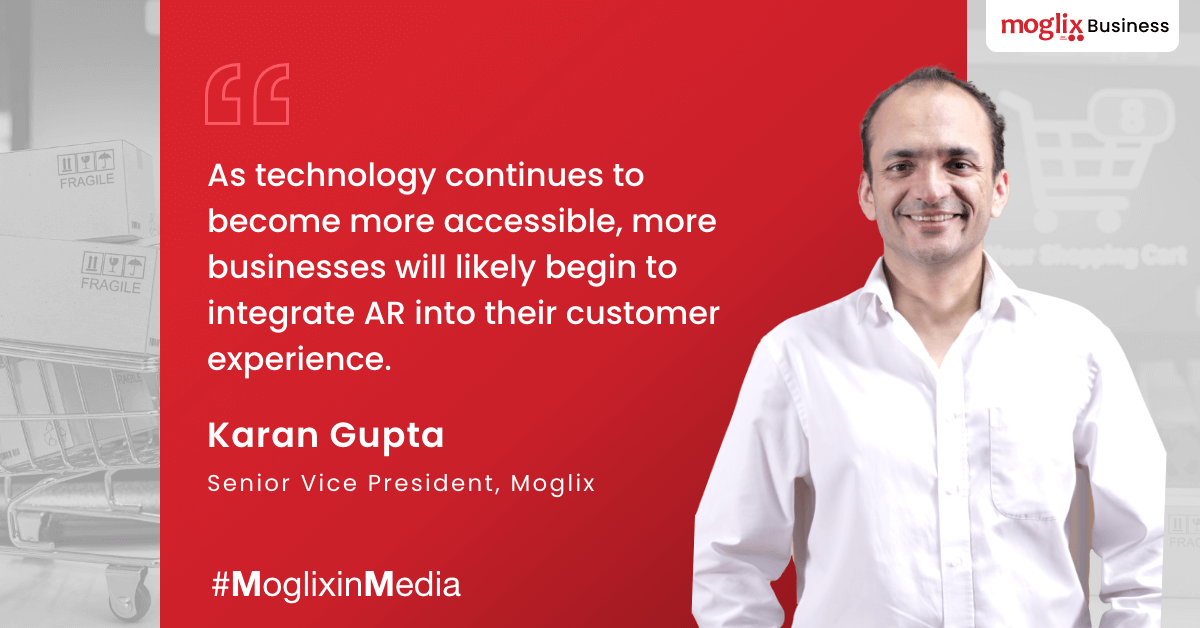
AR for B2B E-commerce: The Future of Immersive Shopping
In the post-pandemic world, direct-to-customer (D2C) businesses face a new challenge-adapting to the changing retail landscape. Augmented reality (AR) is emerging as a key technology solution for creating immersive shopping experiences.
This is particularly true in business-to-business (B2B) e-commerce, where AR-enabled virtual showrooms are becoming increasingly popular. It allows businesses to showcase their products and services to customers more immersively, even when they are not physically present.
The Impact of Gender Diversity on Traditional Industries: Insights from Jigyasa Kishore

The Impact of Gender Diversity on Traditional Industries: Insights from Jigyasa Kishore
In conversation with Adgully, Jigyasa Kishore, Vice President, TAAS and Marketing, Moglix, stresses on leadership being a gender-agnostic concept, the belief in work-life continuum than work-life balance, and more.
How do you think the role and scope of women leaders have widened in the current market ecosystem?
Not much. On the surface, we see plethora of figurative changes, but the ground level reality is grim. Traditional industries such as manufacturing are still grappling with low level of female representation in the workforce.
Industrial Piping: Cautious Optimism for Sustainable Future.
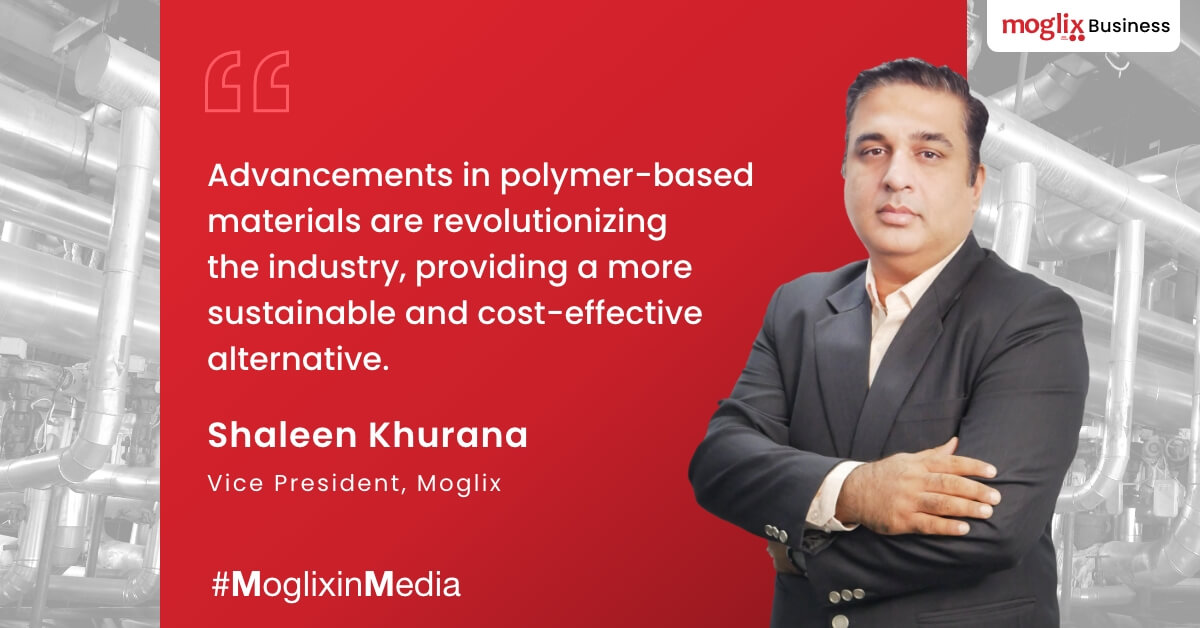
Industrial Piping: Cautious Optimism for Sustainable Future.
While the invention of wheel enabled man to travel from Point A to point B similarly invention of piping systems has eased the transportation of water, I oil, gas, and other resources critical to keep the economy functioning. Piping systems are a remarkable feat of engineering, designed to withstand high pressure, temperature, and corrosive substances. They serve as the lifeblood of many industries.
As the Indian economy continues to grow, industrial piping is expected to follow suit. With the Infra, retail and manufacturing push from GOI, piping demand is poised for a robust growth. (Indian Industrial piping market is growing at 4% CAGR with PVC pipes & fittings growing at a faster pace.
Safety Frontline-A guide to choosing right gumboots for your industry

Safety Frontline-A guide to choosing right gumboots for your industry
Choosing the right gumboots for your job or industry is crucial to ensure proper protection and safety. With so many types of gumboots available, it can be overwhelming to know which one is suitable for your specific needs. Whether you work in construction, agriculture, or food processing ensuring you select the right gumboots for your job in a critical as the job itself.
We have created a industry specific safety gumboots guide which details, features you shouldn’t miss including in your safety gumboots as per the industry you operate in.
Food Processing
In the food processing industry, gumboots are essential to maintain a clean and hygienic work environment. Workers are often exposed to slippery floors, wet conditions, and various food-related substances, such as fats and oils. Therefore, gumboots should have slip-resistant soles, steel toes for impact protection, and chemical-resistant materials that are easy to clean and sanitize.
Mining
Mining is a hazardous industry that requires gumboots that can withstand harsh conditions and protect against various hazards, such as falling objects and chemical exposure. Gumboots for mining should have reinforced steel toes and shanks for impact protection, slip-resistant soles for traction, and chemical resistance to protect against hazardous materials.
Construction
Construction workers are often exposed to various hazards, such as falling objects, sharp objects, and uneven surfaces. Gumboots for construction should have steel toes for impact protection, slip-resistant soles for traction, and good ankle support for stability on uneven terrain.
Agriculture
Agriculture workers often work in muddy or wet conditions and are exposed to various hazards, such as animal waste and sharp objects. Gumboots for agriculture should be comfortable, waterproof, and have good traction to prevent slips and falls.
Chemical Manufacturing
Chemical manufacturing involves exposure to various hazardous chemicals that can cause burns and other health problems. Gumboots for chemical manufacturing should be made from chemical-resistant materials, such as neoprene or other synthetic materials, and have slip-resistant soles for traction.
Fishing
Fishing involves exposure to cold water and slippery surfaces. Gumboots for fishing should have good traction and waterproofing, as well as insulation for cold water.
Cleaning Services
Cleaning services workers are often exposed to wet and slippery surfaces and various cleaning chemicals. Gumboots for cleaning services should have slip-resistant soles, easy-to-clean surfaces, and chemical resistance to protect against exposure to cleaning chemicals.
Plumbing
Plumbers often work in wet and slippery conditions and are exposed to various chemicals and sharp objects. Gumboots for plumbing should have steel toes for impact protection, slip-resistant soles for traction, and chemical resistance to protect against exposure to hazardous materials.
Oil and Gas
Oil and gas workers are often exposed to various hazardous chemicals and conditions, such as extreme temperatures and slippery surfaces. Gumboots for oil and gas should be made from chemical-resistant materials, have good traction and insulation, and be slip-resistant for added safety.
Healthcare
In healthcare, gumboots are essential to protect against exposure to hazardous substances, such as blood and other bodily fluids. Gumboots for healthcare should have slip-resistant soles, chemical resistance, and anti-static properties to prevent the buildup of static electricity.
Choosing the right gumboots for your specific industry and application is essential to protect you at your workplace, and look for gumboots that have the appropriate features, such as slip-resistant soles, steel toes, chemical resistance, and insulation.At Moglix you have access to the widest range of industry and application specific safety gumboots from from best in class brands all in one place. Check our range
Gumboot Guide
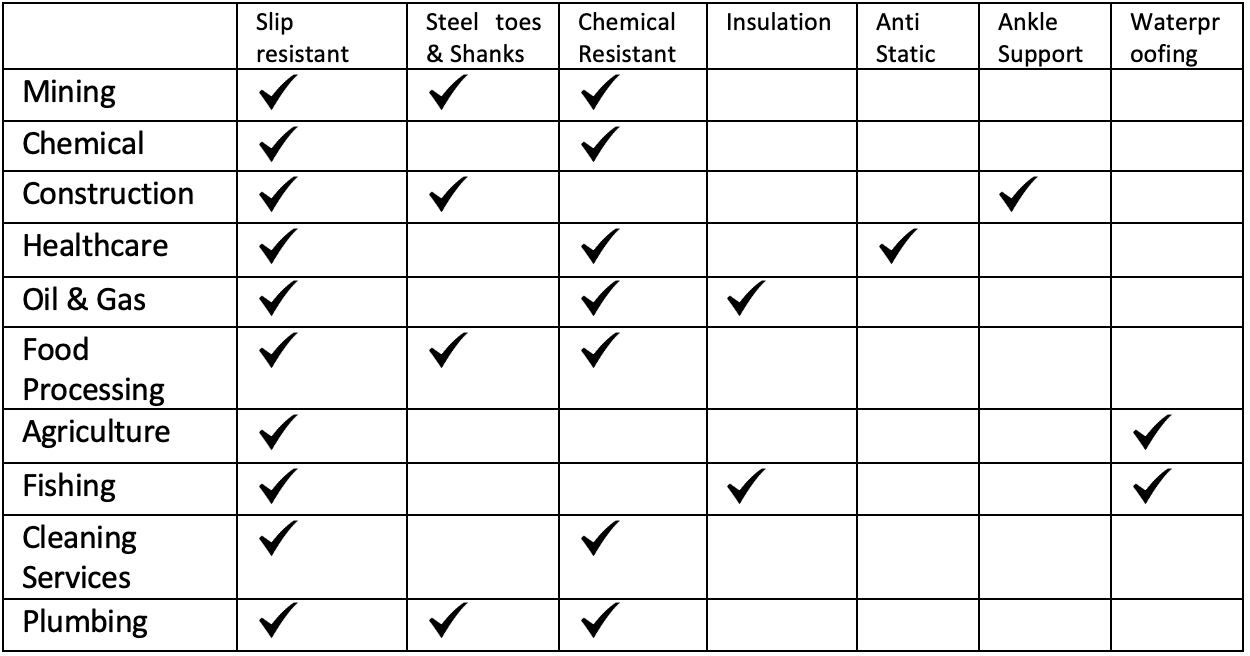
Please Note: This guide is an indicative guide, eventually gumboot material, features and application will depend on your eventual use
Evolution of Safety Gumboots in Workplace Safety: A Comprehensive Guide

Evolution of Safety Gumboots in Workplace Safety: A Comprehensive Guide
Also known as wellies, rubber boots, rain boots, muck boots and many more depending upon the country you are in, Gumboots have been around since the early 19th century. Originally designed for farmers to protect their feet from mud and water, gumboots have evolved over time to become an essential part of personal protective equipment (PPE) in various industries.
Origins of the Gumboots
Gumboots were first invented in Europe for farmers working in wet and muddy conditions. The first gumboots were made of leather, but this material was heavy and didn’t provide adequate protection against water. In the mid-19th century, Charles Goodyear invented vulcanized rubber, which revolutionized the gumboot industry. Rubber gumboots were much lighter and more durable than leather gumboots, and they quickly became popular among farmers and other outdoor workers.
Industrial Revolution
During the Industrial Revolution, gumboots became popular in factories, mines, and other industrial workplaces. Workers needed footwear that could protect their feet from falling objects, chemicals, and other hazards. Rubber gumboots were a perfect fit for these requirements, and they quickly became an essential part of PPE in various industries.
Rubber Technology
The invention of vulcanized rubber paved the way for various innovations in gumboot design and manufacturing. Rubber gumboots could now be produced in different sizes, shapes, and colors. They also became more comfortable to wear, thanks to the development of rubber cushioning and insoles.
World War I and II
During World War I and II, gumboots became crucial for soldiers in the trenches. They protected soldiers’ feet from wet and muddy conditions, as well as from diseases like trench foot. The demand for gumboots during these wars led to significant innovations in gumboot design and manufacturing. For instance, manufacturers started using lighter and more flexible materials to make gumboots that were more comfortable to wear for long periods.
Modern Safety Standards
In the 20th century, safety gumboots became subject to strict safety standards and regulations. These standards were developed to ensure that gumboots provided adequate protection against various hazards in the workplace. Today, safety gumboots are tested for slip resistance, impact resistance, and other safety features before they can be sold to the public. According to a report by Zion Market Research, the global safety footwear market was valued at $6.8 billion in 2020 and is expected to reach $9.8 billion by 2028, growing at a CAGR of 4.8% during the forecast period.
Materials Innovation
In recent years, materials such as neoprene, PVC, and polyurethane have been used in the production of safety gumboots. These materials offer superior resistance to chemicals, oils, and other hazards, making them ideal for use in industries like construction, mining, and agriculture. According to a report by Allied Market Research, the global safety footwear market is expected to witness significant growth due to the increasing demand for lightweight, comfortable, and durable safety footwear.
Global Industry
Today, safety gumboots are produced and used all over the world. Different cultures and industries have influenced the design and development of safety gumboots in different parts of the world. For instance, gumboots used in the agriculture industry in India are designed to be comfortable and breathable, while those used in the mining industry in South Africa are designed to be durable and slip-resistant.
Road ahead
We can expect to see continued innovation in the design and materials used to make gumboots. One promising trend is the growing use of sustainable and eco-friendly materials, which can reduce the environmental impact of these essential safety tools. At the same time, advances in 3D printing technology could allow for greater customization and personalization of gumboots, improving their fit and comfort.
The evolution of gumboots reflects a broader trend in workplace safety, which is a growing recognition of the importance of protecting workers from hazards and providing them with the tools they need to do their jobs safely and effectively. As technology and materials continue to advance, we can expect gumboots to remain a critical part of workplace safety for many years to come. At Moglix you have access to the widest range of industry and application specific safety gumboots from from best in class brands all in one place. Check our range
Procurement: An integral flywheel for the Indian automotive industry

Procurement: An integral flywheel for the Indian automotive industry
Being recognised as the backbone of the economy with 12% of the Gross Value Added (GVA) in the manufacturing sector and a contribution of 49% to India’s manufacturing GDP, 7.5% to the GDP at large, and generating 32 million jobs, the Indian automobile industry is a matter of pride for every Indian citizen.
The Indian automobile industry has indeed magically transformed India’s Gross Domestic Product (GDP) and the overall economy. In terms of market size, the Indian
passenger car market was valued at US$ 32.70 billion in 2021 and is expected to reach a value of US$ 54.84 billion by 2027 while registering a CAGR of over 9% between 2022-27.
The Rise of Cloud Manufacturing: How Collaboration and Eco-Efficiency are Driving Success
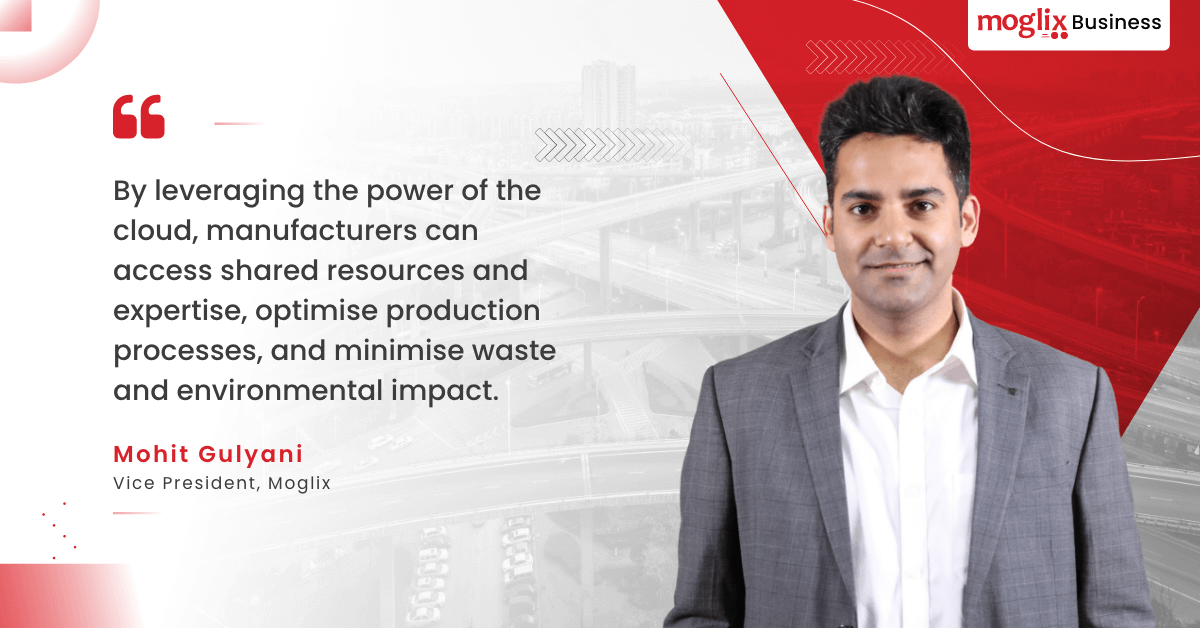
The Rise of Cloud Manufacturing: How Collaboration and Eco-Efficiency are Driving Success
Collaborative and eco-efficient manufacturing is an approach to industrial production that prioritizes collaboration and sustainability. This paradigm shift is a response to the challenges posed by the traditional manufacturing industry that relied on a hierarchical, closed system of production. It also tended to be inflexible and focused on short-term gains rather than long-term value creation. The traditional approach was characterized by:
- A linear, take-make-waste approach that generated significant environmental impacts, including greenhouse gas emissions, pollution, and resource depletion
- A lack of transparency, with manufacturers operating in isolation from their suppliers and customers.
Overheating of Switchgear Components and How to Mitigate It
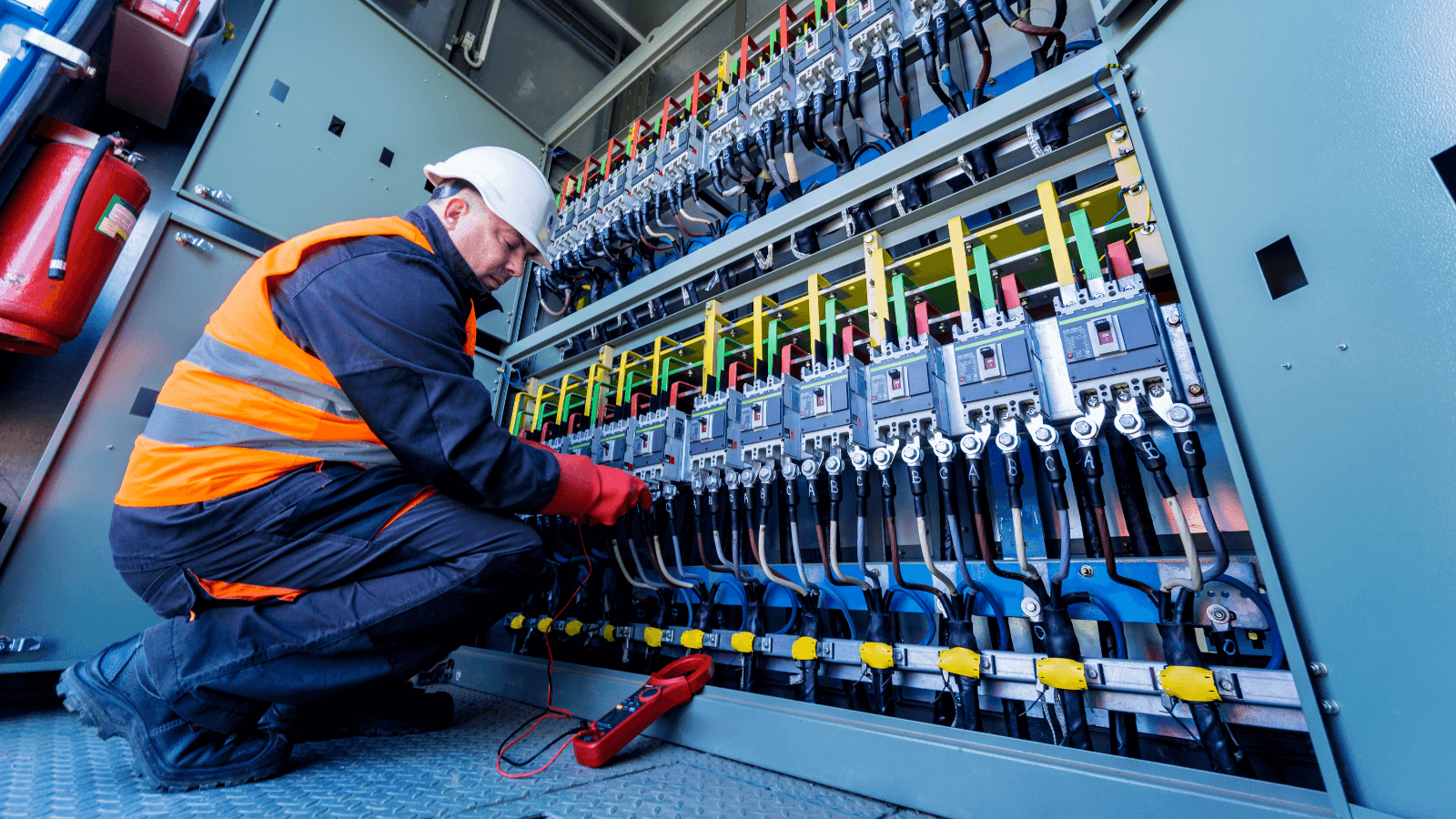
Overheating of Switchgear Components and How to Mitigate It
Switchgear components are essential for the safe and reliable operation of power distribution systems. However, like any electrical equipment, they can be susceptible to overheating. This not only leads to equipment failure and downtime but also poses safety hazards. Therefore, it’s crucial to maintain proper temperature control for switchgear components. Lets understand common causes of switchgear overheating and some practical tips and advanced solutions for mitigating it.
Common Causes of Switchgear Overheating
Overheating of switchgear components can occur due to various reasons, including:
Overloaded circuits: When the electrical load on a switchgear component exceeds its rated capacity, it generates excess heat, leading to overheating.
Poor ventilation: Switchgear components require adequate ventilation to dissipate the heat they generate. Poor ventilation can cause the heat to build up, resulting in overheating.
High ambient temperatures: When the ambient temperature exceeds the switchgear component’s rated temperature, it can lead to overheating.
Inadequate maintenance: Dirty and corroded contacts, worn-out insulation, and loose connections can all cause increased resistance and heat generation, leading to overheating.
Best Practices for Mitigating Switchgear Overheating
To mitigate switchgear overheating, the following best practices should be followed:
Regular inspection and maintenance: Switchgear components should be inspected and maintained regularly to detect any signs of overheating early on.
Proper ventilation: Adequate ventilation is crucial to dissipate the heat generated by switchgear components. The ventilation system should be designed and installed to meet the switchgear manufacturer’s recommendations.
Thermal imaging: Thermal imaging can be used to detect hot spots in switchgear components, enabling early detection and mitigation of overheating.
Load management: Electrical loads should be managed to ensure that they don’t exceed the switchgear component’s rated capacity.
Advanced Solutions for Switchgear Temperature Control
In addition to the best practices mentioned above, the following advanced solutions can be used for switchgear temperature control:
Active cooling systems: Active cooling systems, such as air conditioning and liquid cooling, can be used to cool switchgear components and maintain their temperature within the rated range.
Intelligent temperature monitoring: Intelligent temperature monitoring systems can be used to continuously monitor switchgear components’ temperature and adjust the cooling system as required.
Automated load shedding: Automated load shedding systems can be used to shed excess electrical loads automatically, preventing switchgear components from overheating.
Use Cases
To illustrate the practical applications of the solutions discussed above, let’s look at a few use cases:
- A switchgear component at a manufacturing plant was consistently overheating due to high ambient temperatures. To mitigate this, the plant installed an active cooling system that maintained the component’s temperature within the rated range.
- A thermal imaging survey detected hot spots in a switchgear component at a data center. The hot spots were caused by overloaded circuits. To prevent overheating, the data center implemented load shedding, shedding excess loads automatically to keep the switchgear component within its rated capacity.
Moving Forward
As technology advances, new solutions and innovations for switchgear temperature control are emerging. These include:
Advanced sensors: Advanced sensors can provide more accurate temperature readings, enabling better temperature control and more efficient cooling.
Artificial intelligence: Artificial intelligence can be used to predict when switchgear components are likely to overheat, enabling proactive mitigation.
Renewable energy sources: As more renewable energy sources, such as solar and wind, are integrated into power distribution systems, switchgear temperature control will become even more critical to ensure safe and reliable operation.
Overheating of switchgear components can lead to equipment failure, downtime, and safety hazards. Hence it’s important to identify the common causes of overheating and implement best practices. For all your switchgear supplies you can get in touch with us. Moglix, has the most comprehensive range of switchgear supplies and our pan india network of partners and warehouses ensure no place is remote for us to reach. Know more.
How to Prevent Workplace Electrical Fires: Root Causes and Actionable Strategies
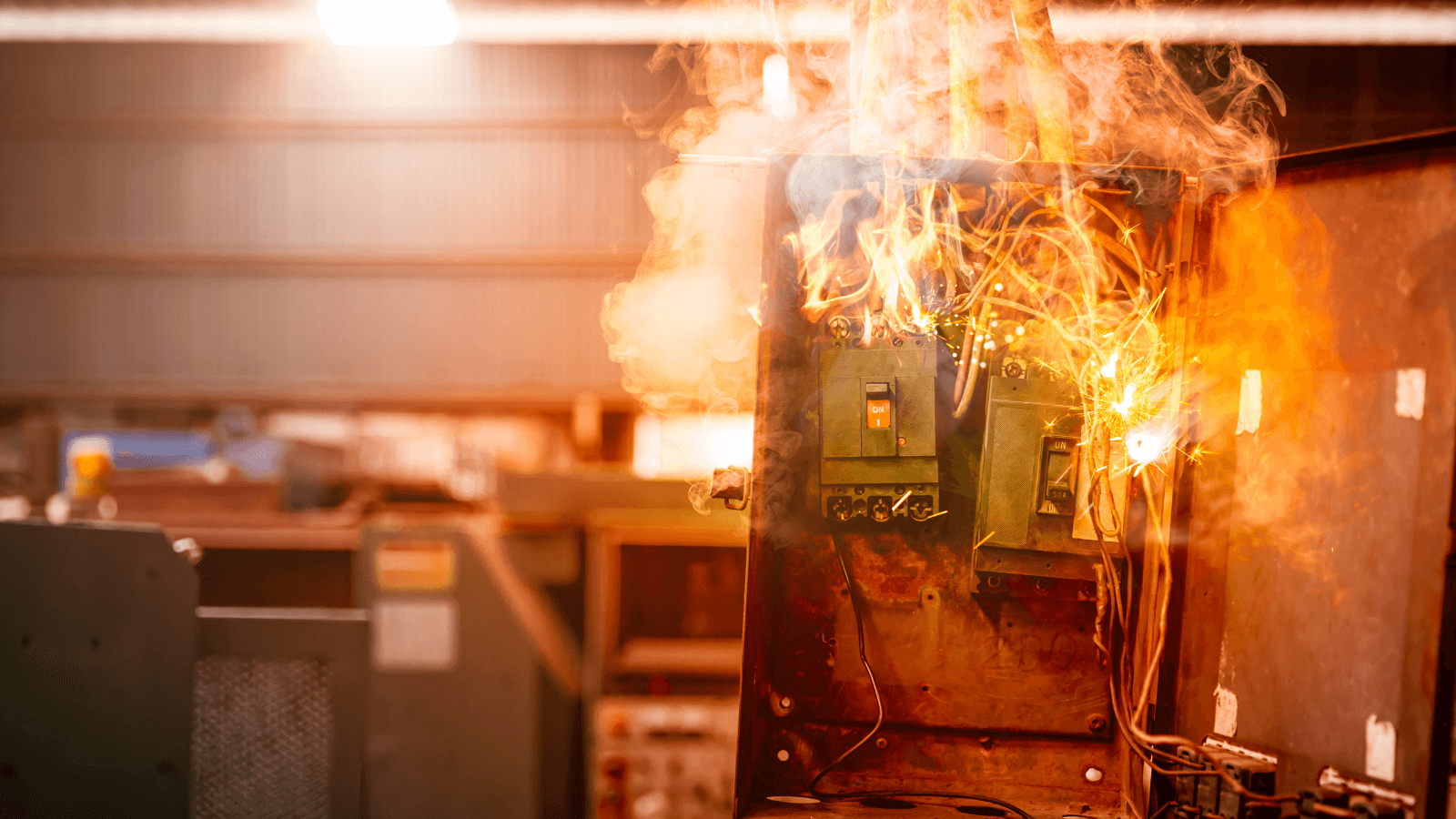
How to Prevent Workplace Electrical Fires: Root Causes and Actionable Strategies
Electrical fires are a common and devastating occurrence in the workplace. A study by the National Crime Records Bureau reveals that workplace electrical fires claimed the lives of 1,808 individuals in 2021 alone, equating to nearly five fatalities per day. However, as with many catastrophic events, the true cost extends beyond mere figures. Lives are forever changed, families grapple with loss, and businesses may never fully recover.
Understanding the causes of workplace electrical hazards and taking proactive measures to mitigate the risks can make all the difference. This blog delves into the causes and costs of workplace electrical fires and explores actionable strategies for businesses to prioritize workplace safety.
Connecting the Dots: Causes of Workplace Electrical Fires
Workplace electrical fires are often caused by faulty electrical equipment, poor electrical installation, improper grounding, overhead power lines, and misuse of electrical equipment. These factors can lead to electrical arcing, igniting nearby flammable materials, and causing a fire. Other common causes of workplace electrical hazards include overloaded circuits, exposed electrical wiring, and improper use of extension cords.
Fanning the Flames: How Workplace Electrical Fires Impact the Bottom Line
The financial cost of workplace electrical fires can be substantial. Beyond the apparent property damage, businesses may also experience a domino effect of losses, from decreased productivity and business interruption to increased insurance premiums. The cost of fire damage restoration and replacement of damaged equipment can quickly add up, and some businesses may not be able to recover from the financial impact of an electrical fire.
Recent studies show that workplace fires account for a staggering USD 328 billion in annual costs in the US alone, with 22% of these fires resulting from electrical sources. With such high stakes, companies must engage in business continuity planning to safeguard their financial health and long-term viability.
Shock-Proof Your Business: Best Practices for Preventing Workplace Electrical Fires
Businesses must prioritize electrical safety to mitigate the risk of workplace electrical fires. This can be achieved by implementing proper electrical installation and maintenance procedures, employee training programs, and regular equipment inspections. Here are some steps that businesses can take to minimize the risk of workplace electrical fires:
Conduct regular electrical safety inspections: Regular inspections of electrical equipment and wiring can help identify potential hazards before they result in a fire and enable electric fire prevention.
Develop an electrical safety program: A comprehensive electrical safety program can provide employees with the knowledge and tools they need to use electrical equipment safely.
Provide regular training: Ongoing training can help employees stay informed about the latest electrical safety practices and guidelines.
Invest in Quality electrical supplies – Invest in high quality electrical supplies like switchgears, wires and cables etc. Best would be to source it from a one stop solution provider like Moglix so that you have access the comprehensive product range from bets in class brands
Ensure proper installation and maintenance: Proper installation and maintenance of electrical equipment can help prevent electrical fires caused limited product understanding. Moglix has on roll electrical experts that can guide through procurement, installation and maintenance cycles.
Promote a culture of workplace safety: Encourage employees to prioritize safety and report any potential hazards immediately.
OSHA Compliance: Ensuring compliance with Occupational Safety and Health Administration standards can also help in fire risk management.
Wiring a Safer Future
Mitigating the risks of workplace electrical fires requires a comprehensive approach that prioritizes electrical safety through regular inspections, employee safety training, and proper equipment installation and maintenance. By taking these steps, businesses can create a safer work environment for their employees and minimize the risks and costs associated with electrical hazards. At Moglix, we are committed to the cause of employee safety in the workplace. Contact us today to explore supplies and solutions that keep your workplace safe from fire related accidents
